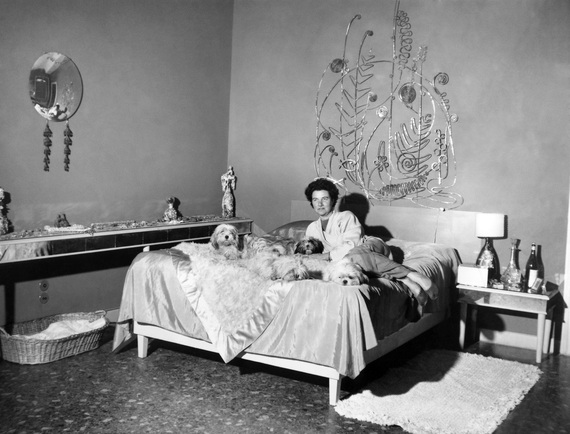Once again we turn to the cinematic mirror to learn what we can about the human condition. On screens now, there are many excellent reviews of the film, "Peggy Guggenheim: Art Addict," on the Huffington Post, in the Hollywood Reporter, and in Variety.
This fine documentary is the follow up to the acclaimed directorial debut of "The Eye Has To Travel,"by Lisa Immordino Vreeland. The director is the grand-daughter in law of her subject Diana, with the same last name.
Both subjects are fascinating looks into women of note. Both were colorful figures and thought leaders, ahead of their times. Both took risks and became cultural icons who helped to define the times they lived in.
Ms. Guggenheim straddled two worlds as a bohemian and a socialite, in the United States and as an expatriate, having lived a couple of decades in Paris and died in Venice, Italy. An heiress to her family's fortune, she was born into New York's, German Jewish, "Our Crowd."
It is interesting to me that Ms. Vreeland was one of this social group's darlings. The film is being shown in a Laemmle Theatre, still owned and operated by a family rooted in the same community.
Not fond of "Our Crowd," Ms. Guggenheim was the ultimate inside outsider as a gallery owner before she was legitimized and championed in her art world efforts by her father's brother, Uncle Solomon. He too was an art collector who placed her in leadership positions in his eponymous museums of note.
Did the acceptance of his niece amplify the courage she possessed to buck convention and will herself into becoming a central figure in the Modern Art movement? She started collecting in her 40's in the late thirties, just as WWII was erupting in Europe. It was said she bought a painting a day, one step ahead of Nazism that was encroaching and shutting down the party.
Ms. Guggenheim came into her fullness in the cultural and political upheaval of the 20th century. She collected art and artists. No doubt the title of the movie insinuates, subtly and playfully, that Ms. Guggenheim - who was open about her appetites - had a penchant for carnal pleasures.
Her intimate history included such luminaries as the playwright Samuel Beckett and she wed painter Max Ernst. She had an affair with the married, Jackson Pollock whom she discovered when he was a carpenter, Alexander Calder, and Marcel Duchamp. This is a sampling of the many talented people she bed.
Who knows what motivated Ms. Guggenheim? She experienced more than her fair share of tragedy, losing her only daughter and beloved sister to suicides. Her doting but distracted father died on board the Titanic with his mistress when she was 14. After his death she was left at home with a mentally unstable mother, bristling at the conventions of a staid bourgeoisie life that was suffocating, boring and lonely.
The film implies that Ms. Guggenheim was insecure about her unconventional good looks and speech impediment. She had strong facial features, particularly her nose. I would have challenged her. In my opinion she was stylish and statuesque.
Art addict, or was it sex addict, or just a healthy appetite? Did her abandonment by an absent dad play out as she looked for replacement father figures in self involved writers and artists? She married and divorced three of them.
At one point Ms. Guggenheim, or La Dogaressa, her nickname, kept 14 lap dogs. Was the desire to surround herself with man's best friend, who provided unconditional love, and objects of beauty to reflect on; were these strategies, conscious or not, to distance herself from insecurities or even numb emotional pain? After all, it is easier to relate to art and animals than other people.
We are left with a portrait of a vital, enigmatic and fascinating woman. She possessed an eye for talent and was sure of herself enough to be surrounded by smart advisers. At no time should this blog be a substitute for therapy or to be construed as advice. Rather, it is a peek into understanding how I think.
If you - or someone you know - have questions about your own life, or are suicidal, do not hesitate to reach out to someone you trust or seek professional treatment.

